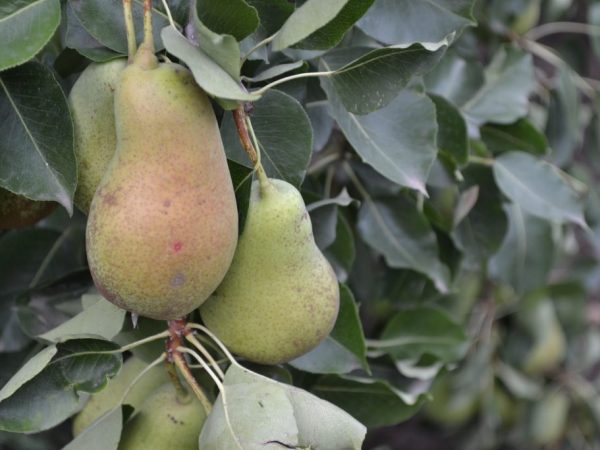Characteristics of the pear variety Miracle
Pear Chudesnitsa is a new winter variety of pears obtained by Russian scientists as a result of crossing.

Characteristics of the pear variety Miracle
Variety characteristic
According to the description, the Miracle pear variety is characterized by:
- good winter hardiness (calmly tolerates a temperature of -38 ° C without freezing of the bark and damaging cambium tissues);
- high productivity;
- medium fruiting (the tree bears fruit 5-6 years after planting);
- duration of consumption (fruits are stored for up to 4 months, provided that the room is cool);
- harvesting in the second and third decades of September; durability (yields yields up to 50-70 years);
- picky about the soil;
- ripening fruits in a plucked state to gain taste and sweetness.
Description of the tree
According to the description, pears of the Kudesnitsa variety are vigorous. Their crown has an oval shape and an average level of density. The main disadvantage is a decrease in fruit due to thickening of the crown. The bush has a mixed type of fruiting. The shoots of this fruit tree are relatively thin and greenish brown, with small buds and relatively small green leaves with a rounded upward curving shape.
The ideal time for planting a pear seedling is autumn, but you can plant it in spring, but in this case, the planting pits are prepared in the fall.
Description of the fetus
The average weight of the fruit varies from 130 to 200 g. The shape is slightly elongated, regular. The skin of the fruit is oily and smooth to the touch, with a slight waxy bloom.
The fruit of this fruit tree is characterized by closed seed chambers. Small saucer, straight, medium-sized stalk. The seeds are also small and narrow. During ripening, the fruit has a deep yellow color, sometimes with a blurred blush.
The pulp is white and tender, most often oily. The fruit tastes sweet, with a slight sourish aftertaste, and has a weak aroma. This fruit is actively used for the preparation of some varieties of wines and various sweets. It is also popular in traditional medicine. Sometimes it is used in the production of medications for a number of viral diseases.
Care
Pear Miracle, according to the description of gardeners, does not require special care. All she needs is:
- access to direct sunlight (the best option for landing is the south or west side);
- preferably drained and fertile soils;
- moderate soil moisture, since excessive moisture and moisture stagnation harm the fruit tree;
- mandatory pruning (any method is suitable: shortening, transferring to branches, thinning);
- optimal irrigation system - sprinkling with a spray that simulates natural rain;
- loosening to provide the soil with oxygen after irrigation;
- fertilization in autumn and spring, starting from the second year;
- good insulation of the roots in the cold season, while the trunk is wrapped with foil or paper.

The tree is easy to care for
If the tree grows in a soil with high levels of sand or clay, the soil is prepared in advance. The best option is to manually change the land warehouse. This requires:
- purchase 2-3 bags of ready-made soil mixture for fruit trees;
- dig a small pit on the site planned for planting a crop;
- mix the soil taken from the pit with the prepared soil mixture in the proportion of 3 m of soil mixture per 1 m of local soil.
Part of the prepared mixture is placed on the bottom of the pit, and part is left to cover the roots of the seedling.
Diseases
One of the main positive qualities of the Chudesnitsa variety is its disease resistance.
It does not suffer from the common scab in temperate climates, which gives it a significant market advantage over other fruits. The tree does not infect entomosporia, which negatively affects the process of bud formation and gives the leaves a brown color.
Pests
The main danger is pests:
- brown fruit mite;
- bluehead scoop;
- goose;
- mole.
Brown fruit mite
Brown fruit mites hibernate in cracks in the bark, and in spring they molt and lay eggs on leaves. In less than a month, the larvae become adult mites. The cycle is repeated many times.
To combat the brown fruit mite, the tree is sprayed with acaricides in the spring. The drug used is changed so that the ticks do not develop immunity to it. If the lesions are too severe, they resort to using nitrafen or oleocobrite.
Bluehead scoop
It is a large butterfly with brown wings that lays eggs in the crown of trees for the winter. To combat it, the branches are regularly inspected and the caterpillars are shaken off, followed by the destruction of the pest.
If the invasion of the blue-headed scoop turns out to be massive, the tree is treated with insecticides. Do this before flowering.
Goose
In spring, hawthorn caterpillars eat buds, leaves and flowers. The females of the apple grower lay eggs in buds (on average, one female can lay up to a hundred eggs), as a result, the petals stick together, after which the bud dries up. Pear leaf gall midge sucks the juice from the leaves.
Moth
Fruit moth is no less dangerous for the variety. With a large-scale invasion, the tree is left without leaves. To prevent this, fruit trees are sprayed with hot pepper infusion.
Conclusion
The Wonderful pear variety has not yet gained popularity among gardeners, but a large number of advantages over other winter varieties distinguish this species from other fruit trees. The main ones are a large yield and large size of fruits, the possibility of long-term storage of fruits and the tree's immunity to diseases common among fruit trees.


